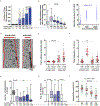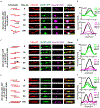Differential regulation of single microtubules and bundles by a three-protein module
- PMID: 34083810
- PMCID: PMC8387365
- DOI: 10.1038/s41589-021-00800-y
Differential regulation of single microtubules and bundles by a three-protein module
Abstract
A remarkable feature of the microtubule cytoskeleton is the coexistence of subpopulations having different dynamic properties. A prominent example is the anaphase spindle, where stable antiparallel bundles exist alongside dynamic microtubules and provide spatial cues for cytokinesis. How are the dynamics of spatially proximal arrays differentially regulated? We reconstitute a minimal system of three midzone proteins: microtubule-crosslinker PRC1 and its interactors CLASP1 and Kif4A, proteins that promote and suppress microtubule elongation, respectively. We find that their collective activity promotes elongation of single microtubules while simultaneously stalling polymerization of crosslinked bundles. This differentiation arises from (1) strong rescue activity of CLASP1, which overcomes the weaker effects of Kif4A on single microtubules, and (2) lower microtubule- and PRC1-binding affinity of CLASP1, which permits the dominance of Kif4A at overlaps. In addition to canonical mechanisms where antagonistic regulators set microtubule length, our findings illuminate design principles by which collective regulator activity creates microenvironments of arrays with distinct dynamic properties.
© 2021. The Author(s), under exclusive licence to Springer Nature America, Inc.
Figures















Similar articles
-
Geometry of antiparallel microtubule bundles regulates relative sliding and stalling by PRC1 and Kif4A.Elife. 2018 Oct 24;7:e32595. doi: 10.7554/eLife.32595. Elife. 2018. PMID: 30353849 Free PMC article.
-
Self-Organization of Minimal Anaphase Spindle Midzone Bundles.Curr Biol. 2019 Jul 8;29(13):2120-2130.e7. doi: 10.1016/j.cub.2019.05.049. Epub 2019 Jun 20. Curr Biol. 2019. PMID: 31231047 Free PMC article.
-
Microtubule-sliding modules based on kinesins EG5 and PRC1-dependent KIF4A drive human spindle elongation.Dev Cell. 2021 May 3;56(9):1253-1267.e10. doi: 10.1016/j.devcel.2021.04.005. Epub 2021 Apr 27. Dev Cell. 2021. PMID: 33910056 Free PMC article.
-
A MAP for bundling microtubules.Cell. 2010 Aug 6;142(3):364-7. doi: 10.1016/j.cell.2010.07.023. Cell. 2010. PMID: 20691897 Review.
-
Mechanisms of the Ase1/PRC1/MAP65 family in central spindle assembly.Biol Rev Camb Philos Soc. 2019 Dec;94(6):2033-2048. doi: 10.1111/brv.12547. Epub 2019 Jul 25. Biol Rev Camb Philos Soc. 2019. PMID: 31343816 Review.
Cited by
-
Coupling of microtubule bundles isolates them from local disruptions to set the structural stability of the anaphase spindle.Proc Natl Acad Sci U S A. 2022 Sep 27;119(39):e2204068119. doi: 10.1073/pnas.2204068119. Epub 2022 Sep 19. Proc Natl Acad Sci U S A. 2022. PMID: 36122237 Free PMC article.
-
KIF2A stabilizes intercellular bridge microtubules to maintain mouse embryonic stem cell cytokinesis.J Cell Biol. 2025 Jul 7;224(7):e202409157. doi: 10.1083/jcb.202409157. Epub 2025 May 12. J Cell Biol. 2025. PMID: 40353778
-
Lateral and longitudinal compaction of PRC1 overlap zones drives stabilization of interzonal microtubules.Mol Biol Cell. 2023 Sep 1;34(10):ar100. doi: 10.1091/mbc.E23-02-0049. Epub 2023 Jul 19. Mol Biol Cell. 2023. PMID: 37467037 Free PMC article.
-
Microtubule rescue at midzone edges promotes overlap stability and prevents spindle collapse during anaphase B.Elife. 2022 Mar 16;11:e72630. doi: 10.7554/eLife.72630. Elife. 2022. PMID: 35293864 Free PMC article.
-
ASPM Induces Radiotherapy Resistance by Disrupting Microtubule Stability Leading to Chromosome Malsegregation in Non-Small Cell Lung Cancer.Exploration (Beijing). 2025 May 7;5(4):e20230024. doi: 10.1002/EXP.20230024. eCollection 2025 Aug. Exploration (Beijing). 2025. PMID: 40873651 Free PMC article.
References
Methods References
-
- Hyman A et al.Preparation of modified tubulins. Methods Enzymol 196, 478–485 (1991). - PubMed
-
- Koppel DE Analysis of macromolecular polydispersity in intensity correlation spectroscopy: the method of cumulants J Chem Phys 57, 4814–4820 (1972)
Publication types
MeSH terms
Substances
Grants and funding
LinkOut - more resources
Full Text Sources
Molecular Biology Databases
Miscellaneous

